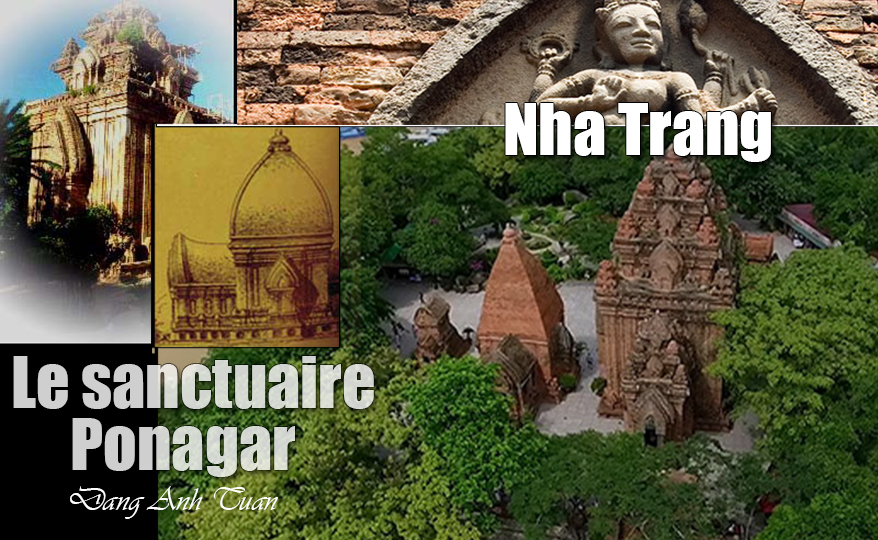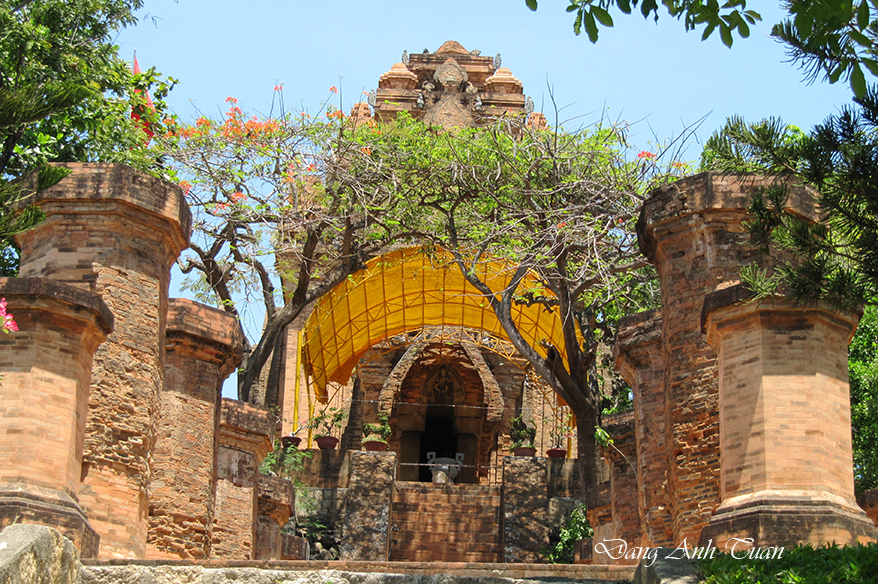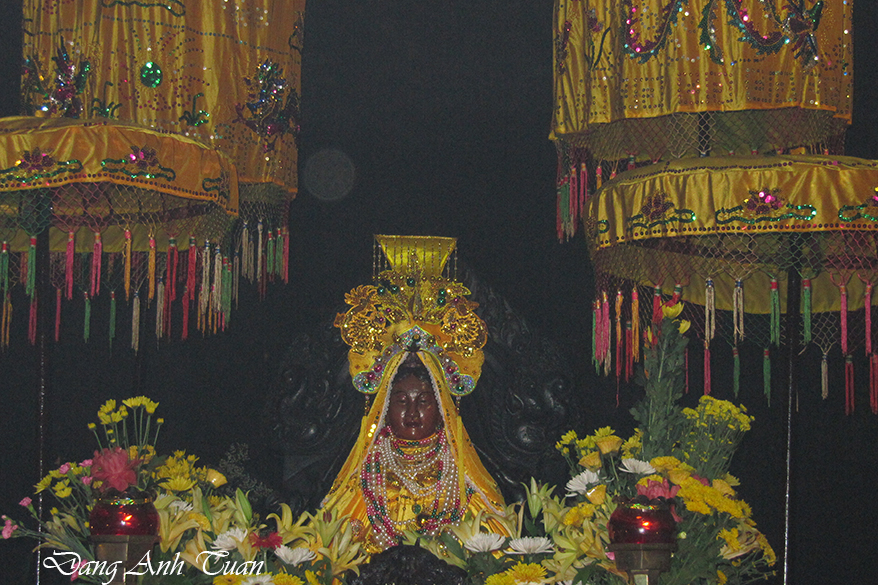Thánh Địa Po Nagar
This sanctuary is a must-visit for those who have the opportunity to visit Nha Trang, the most upscale seaside resort in Vietnam. Located on a hill at the mouth of the Cái River, it was built continuously from the 8th to the 13th century according to inscriptions found on site. The appearance of this sanctuary in the Champa kingdom is linked to the turmoil that Champa experienced in the 8th century. The Champa kingdom was actually a federation of several states or rather « city-states, » with the most powerful one playing the role of « leader » (vai trò chủ đạo). Upon the advent of a new dynasty, its pura ascended to the top rank and thus became the capital of the kingdom. Thanks to Chinese historical documents and Cham inscriptions, it is known that until the beginning of the 7th century, the pura (or city-state) of Singhapura (lion citadel) in Trà Kiệu (in the current district of Duy Xuyên, Quảng Nam province) predominated.
At that time, the northern royal lineage was always protected by the male deity Bhadresvara, a linga representing a benevolent form of Shiva honored in the most sacred sanctuary of Mỹ Sơn. A new royal lineage soon made itself recognized in the mid-8th century in the southern part of the Champa kingdom (Kauthara) and needed another deity to protect it.
Po Nagar Shrine
The Trà Kiệu and Mỹ Sơn region, belonging to the current Quảng Nam province (the Cham province of Amaravâti), thus lost its importance in favor of Khánh Hòa (Nha Trang plain) and Ninh Thuận (Phan Rang region). Although its political center of power (Virapura) has not been located to this day, it is claimed to be somewhere around Phan Rang. On the other hand, it is certain that a major political event took place in the south of this kingdom, as this perfectly aligns with the date 758 provided in Chinese annals to mark the beginning of the Huanwang period (or Hoàn Vương in Vietnamese), lasting about 100 years. Lin Yi (or Lâm Ấp in Vietnamese), the former name given to this kingdom, is no longer used and is replaced by Huanwang in Chinese texts. This deity is a one-faced linga and is honored in the sacred Pô Nagar sanctuary located by the sea. She is clearly feminine and presented as the shakti of Shiva, Bhagavati.
Despite the sidelining of the Prathivindravarman lineage of the South reported in Chinese annals in 859 and the seizure of supreme power by the Bhrgu lineage in the northern kingdom at Indrapura (near Hội An) in 875 with the new king Indravarman II, the deity of Nha Trang in Kauthara continued to be honored as the protective goddess of the kingdom.
This shows the willingness of the Bhrgu lineage to integrate it into a coherent religious system which, until then based on the veneration of Bhadresvara (Mỹ Sơn sanctuary), recognizes a complementary position for Bhagavarti. The religious bipolarity around the god Bhadresvara at Mỹ Sơn and the goddess Bhagavati at Nha Trang would henceforth dominate the entire kingdom. The veneration of Bhagavarti aligns not only with the importance given to the matrilineal system adopted by the Chams but also with the unity the Chams needed at that time in the face of their enemies (Vietnamese, Khmers, and Javanese).
In order to acclimate to an unfamiliar natural environment where the stupas and religious constructions of the Chams, bearing the deep mark of Indian culture, were visibly strange, frightening, and mysterious with statues of Brahma, Shiva, Vishnu, and Pô Nagar, these new Vietnamese arrivals were forced to develop a lifestyle adapted to their new cultural environment. They did not hesitate to use the remnants of Cham culture to transpose them into their own religious universe and places of worship. They attempted to establish harmony between the supernatural and temporal powers of the territories they had managed to conquer. Fearing to disturb local spirits capable of bringing them harm, they sometimes appropriated the places of worship of the defeated or local people. This is the case of the Pô Nagar sanctuary where the Champa goddess Uma was appropriated by the Vietnamese. They did not hesitate to assimilate the legend of Po Nagar into a mythology arranged in their own way without managing to erase the Cham substrate of the myth. The Champa goddess thus became Thiên Y A Na (Thiên Y Thánh Mẫu) of the Vietnamese. This appropriation is renewed in other places in Vietnam during the southward march: the Black Lady in Tây Ninh or the goddess Chúa Xứ on Mount Sam (Châu Đốc).
In his inventory of Cham towers located on the Pô Nagar site, the French archaeologist Henri Parmentier recorded about a dozen worship buildings grouped in an area of 500 m2 at the top of a hill. Due to weathering and war, only 5 buildings remain spread over two construction levels. At the top, there are two rows of towers, the first consisting of three towers from north to south: the main tower dedicated to the goddess Yan Pu Nagara (or Thiên Y A Na in Vietnamese), the southern temple, and the southeastern kalan. As for the second row, only one tower with a curved saddle-shaped roof remains, dedicated to the children of Thiên Y A Na.
Facing the main tower of the first row, at the lower level, stands an open mandapa consisting of two rows of ten octagonal brick columns, each measuring three meters in height and more than one meter in diameter, surrounded by fourteen similar columns of smaller size. These columns were intended to support a roof shaped like an inverted boat hull, whose structure was made of wood.
This mandapa was built by Senapati Par and mentioned in the steles erected by this general of King Harivarman in 817. It was connected to the main tower by a brick staircase. This type of building is found at other Cham sites: Mỹ Sơn (Đà Nẵng), Po Kloong Garai (Phan Rang), or Bánh Ít (Bình Định). According to Henri Parmentier, next to these brick buildings, there was a wooden temple (or bimong in Cham) which was somewhat a resting place for offerings.
Thanks to Cham inscriptions, we learn that in 774, the wooden religious sanctuary of Pô Nagar was pillaged and destroyed by the Javanese (Chà Và in Vietnamese). This term refers to the populations of the South Seas, i.e., the archipelago and the Malay Peninsula. It was rebuilt in 784 in brick and stone by King Satyavarman. Then, around the middle of the 10th century, the site of Nha Trang was sacked by the Khmers, whose inscriptions spoke of the loot (a gold statue) taken from the goddess Bhagavati.
It was reinstalled in 965 by replacing a stone statue by King Indravarman. The 10th-century statue under the reign of King Jaya Paramesvaravarman could be the one still seen today in the main tower, but its head was restored in the Vietnamese style.



